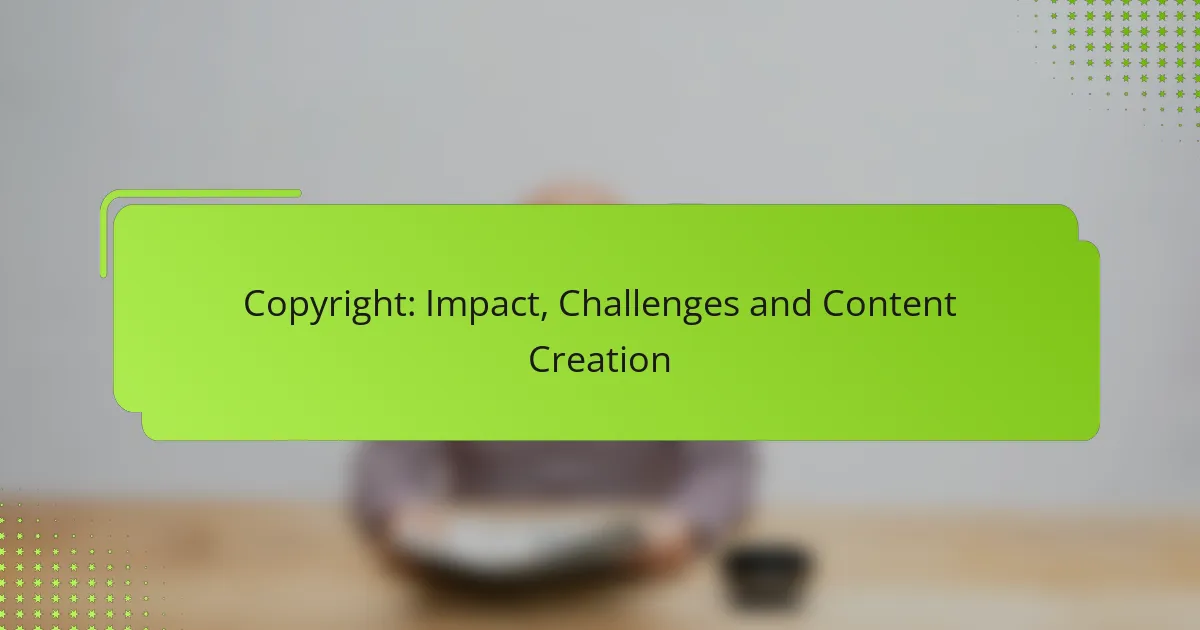Releases and permissions are crucial components in managing media and project-related content, ensuring that all legal and ethical standards are met. The process involves obtaining consent from individuals or entities, clear documentation, and regular audits to maintain compliance. By following best practices, organizations can minimize legal risks and enhance overall project efficiency.
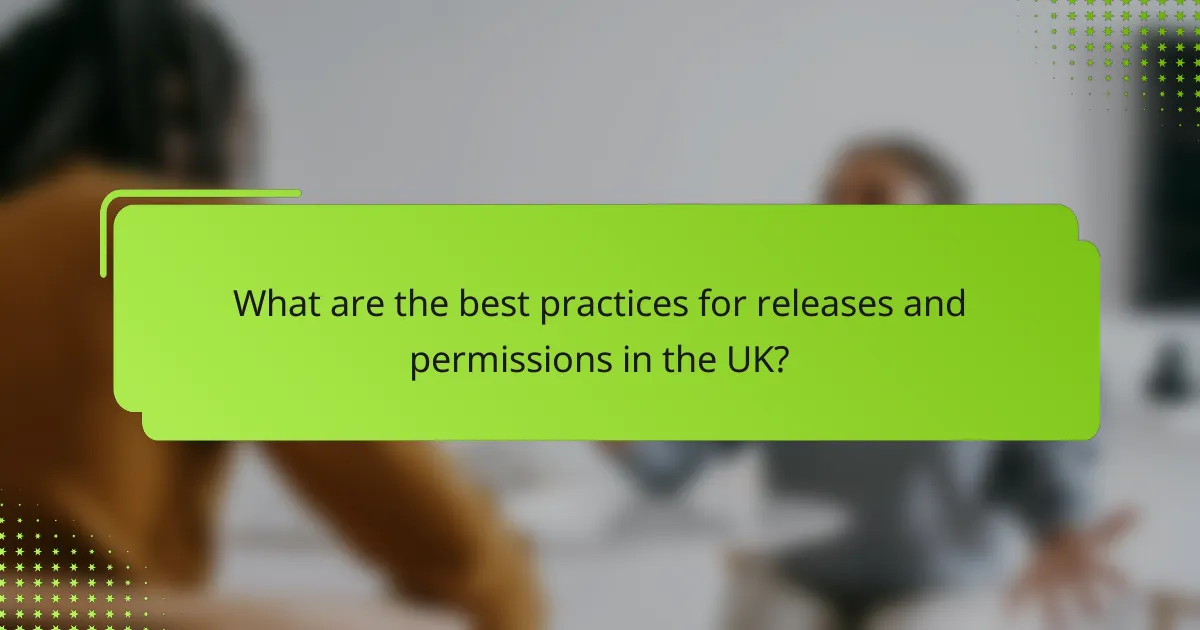
What are the best practices for releases and permissions in the UK?
Best practices for releases and permissions in the UK involve clear documentation, regular audits, effective communication with stakeholders, and compliance with GDPR. These practices ensure that all parties understand their rights and obligations, minimizing legal risks and enhancing project efficiency.
Clear documentation
Clear documentation is essential for managing releases and permissions effectively. It should detail the scope of permissions granted, the duration, and any conditions attached. This clarity helps prevent misunderstandings and ensures that all parties are aligned on their responsibilities.
Utilize templates for consistency and include key elements such as the names of involved parties, specific rights granted, and any limitations. Regularly updating documentation as projects evolve is crucial to maintaining accuracy.
Regular audits
Conducting regular audits of releases and permissions helps identify any discrepancies or compliance issues. These audits should assess whether all permissions are still valid and being adhered to, ensuring that outdated permissions are revoked promptly.
Establish a schedule for audits, such as quarterly or bi-annually, and involve relevant stakeholders in the process. This proactive approach minimizes risks and enhances accountability across the organization.
Stakeholder communication
Effective communication with stakeholders is vital for the successful management of releases and permissions. Regular updates and discussions about changes in permissions or project scope help maintain transparency and trust among all parties involved.
Utilize various communication channels, such as meetings, emails, or project management tools, to keep everyone informed. Encourage feedback and address any concerns promptly to foster a collaborative environment.
Compliance with GDPR
Compliance with GDPR is a critical aspect of managing releases and permissions in the UK. Organizations must ensure that any personal data involved in permissions is handled according to GDPR principles, including obtaining explicit consent where necessary.
Regularly review data handling practices and update permissions to reflect any changes in data protection laws. Training staff on GDPR requirements can also help mitigate risks and ensure compliance across the organization.
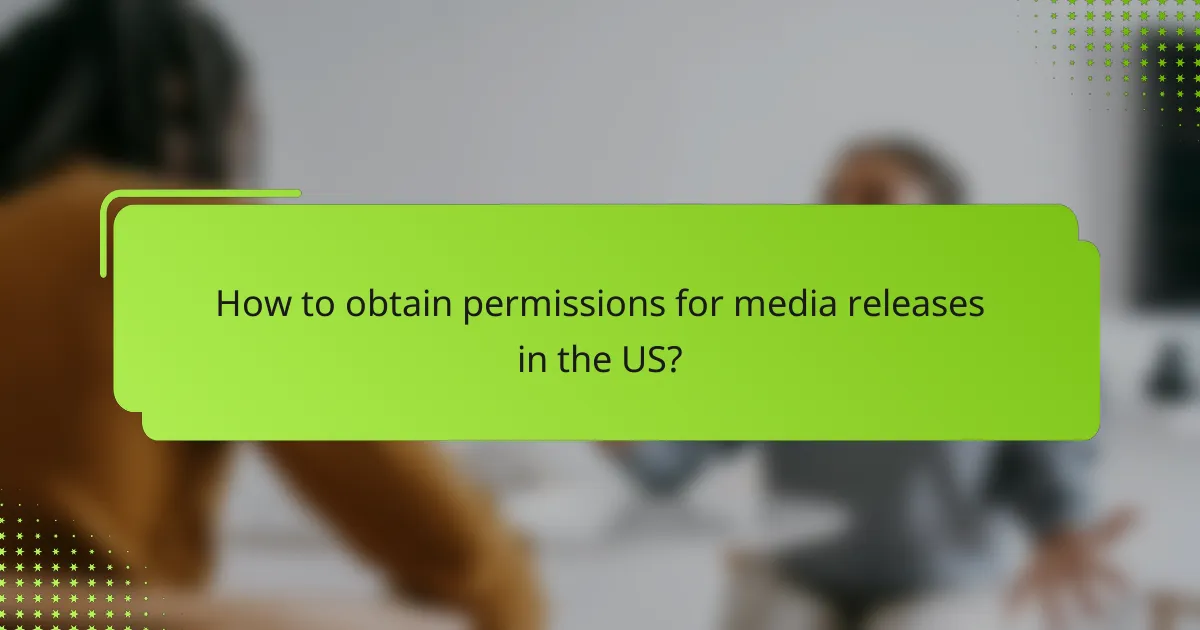
How to obtain permissions for media releases in the US?
To obtain permissions for media releases in the US, you must secure consent from individuals or entities featured in your media. This process typically involves identifying the necessary permissions, drafting clear release forms, and consulting legal experts to ensure compliance with applicable laws.
Identify necessary permissions
Start by determining who needs to grant permission for the use of their likeness, voice, or other identifiable attributes in your media. This often includes actors, musicians, or anyone featured prominently in the content. Additionally, consider permissions related to locations, brands, or copyrighted materials that may be included.
For example, if your media features a well-known landmark, you may need to obtain location releases, especially if the site is privately owned. Always assess the context of your media to identify all necessary permissions.
Draft clear release forms
Once you know who needs to provide permission, draft release forms that clearly outline the scope of usage, duration, and any compensation involved. A well-structured release form should specify how the media will be used, whether for commercial or non-commercial purposes, and include any limitations on usage.
For instance, a release form for a promotional video might state that the individual’s likeness can be used in advertising materials for a specified period. Ensure that the language is straightforward and that all parties understand their rights and obligations.
Consult legal experts
Before finalizing your media release, consult with legal experts who specialize in intellectual property and media law. They can help you navigate complex regulations and ensure that your release forms comply with state and federal laws. This step is crucial to avoid potential legal disputes down the line.
Legal advice can also help you understand the implications of using certain types of media, such as music or stock footage, which may have additional licensing requirements. Engaging a legal expert can save you time and resources by preventing costly mistakes.
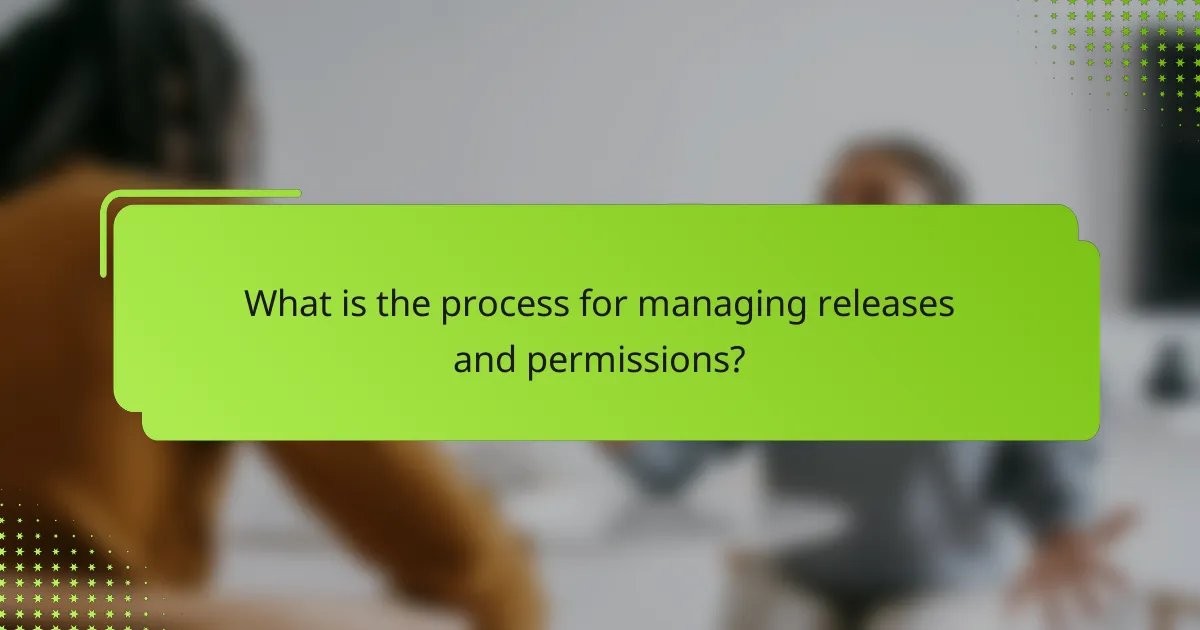
What is the process for managing releases and permissions?
The process for managing releases and permissions involves several key steps to ensure that all necessary approvals are obtained and documented. This typically includes assessing needs, drafting relevant documents, and implementing a system to track permissions effectively.
Initial assessment of needs
Begin by identifying the specific releases and permissions required for your project. Consider factors such as the scope of the project, the stakeholders involved, and any regulatory requirements that may apply. This assessment helps in determining the types of permissions needed, whether they are for intellectual property, data usage, or other areas.
Engage with relevant stakeholders early in the process to gather input and clarify expectations. This collaboration can help prevent misunderstandings and ensure that all necessary permissions are accounted for from the outset.
Drafting and reviewing documents
Once the needs are assessed, draft the necessary documents that outline the permissions being requested. These documents should clearly specify the scope, duration, and any limitations of the permissions. Use plain language to ensure that all parties understand the terms.
After drafting, conduct a thorough review process. Involve legal or compliance teams to ensure that the documents meet all regulatory standards and adequately protect your organization’s interests. This step is crucial to avoid potential legal issues later on.
Implementing a tracking system
Establish a tracking system to monitor the status of all releases and permissions. This system can be a simple spreadsheet or a more sophisticated project management tool, depending on the complexity of your project. Ensure that it includes key details such as request dates, approval statuses, and expiration dates.
Regularly update the tracking system to reflect any changes or new permissions obtained. This practice helps maintain transparency and accountability, making it easier to manage ongoing projects and future releases effectively.
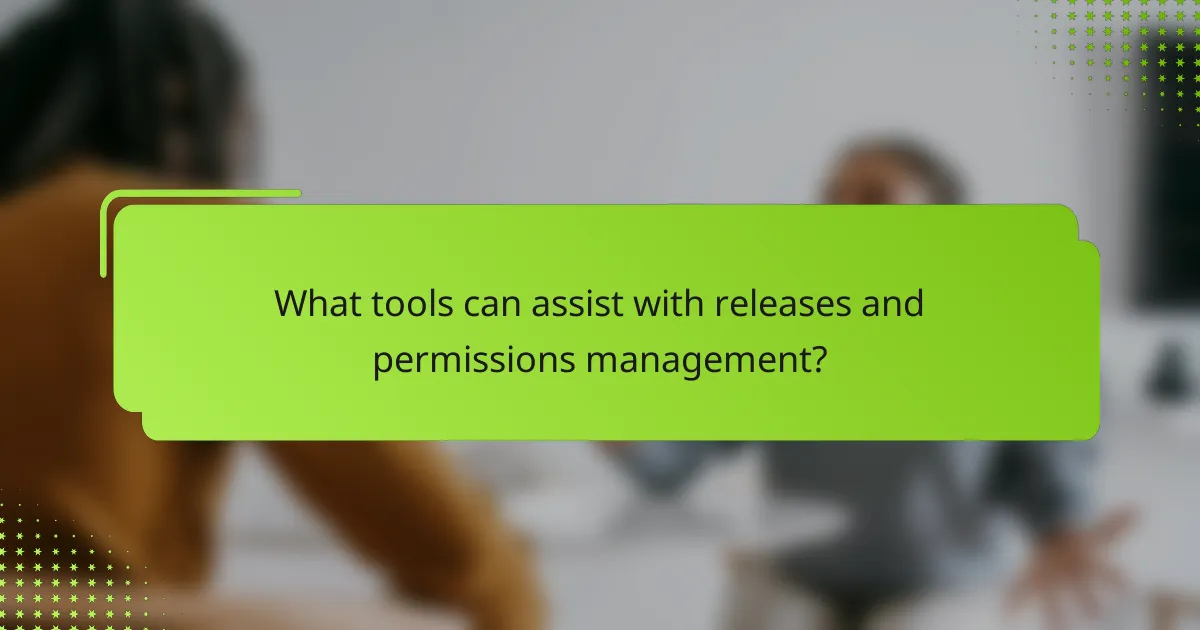
What tools can assist with releases and permissions management?
Several tools can streamline the management of releases and permissions, enhancing efficiency and compliance. Utilizing the right software can simplify processes, ensure secure document handling, and facilitate collaboration among team members.
DocuSign for electronic signatures
DocuSign is a leading platform for obtaining electronic signatures, making it easier to manage release approvals. It allows users to send documents for signature via email, track their status, and store signed documents securely. This eliminates the need for physical paperwork and speeds up the approval process.
When using DocuSign, ensure that all parties understand how to access and sign documents. Familiarize yourself with its features, such as templates and reminders, to optimize your workflow. Always verify the identity of signers to maintain compliance with legal standards.
Google Drive for document sharing
Google Drive is an effective tool for sharing documents related to releases and permissions. It enables users to store files in the cloud, making them accessible from anywhere with an internet connection. You can easily share documents with specific individuals or groups, controlling their access levels.
To maximize Google Drive’s utility, organize your files into clearly labeled folders and set appropriate sharing permissions. Regularly review access settings to ensure only authorized personnel can view or edit sensitive documents. Consider using Google Docs for collaborative editing, which allows real-time feedback and updates.
Asana for project management
Asana is a robust project management tool that helps teams track tasks related to releases and permissions. It allows users to create projects, assign tasks, set deadlines, and monitor progress, ensuring that all aspects of the release process are managed efficiently.
When using Asana, break down the release process into manageable tasks and assign them to team members. Utilize features like due dates and priority levels to keep everyone on track. Regularly update the project status to reflect progress and address any potential bottlenecks promptly.
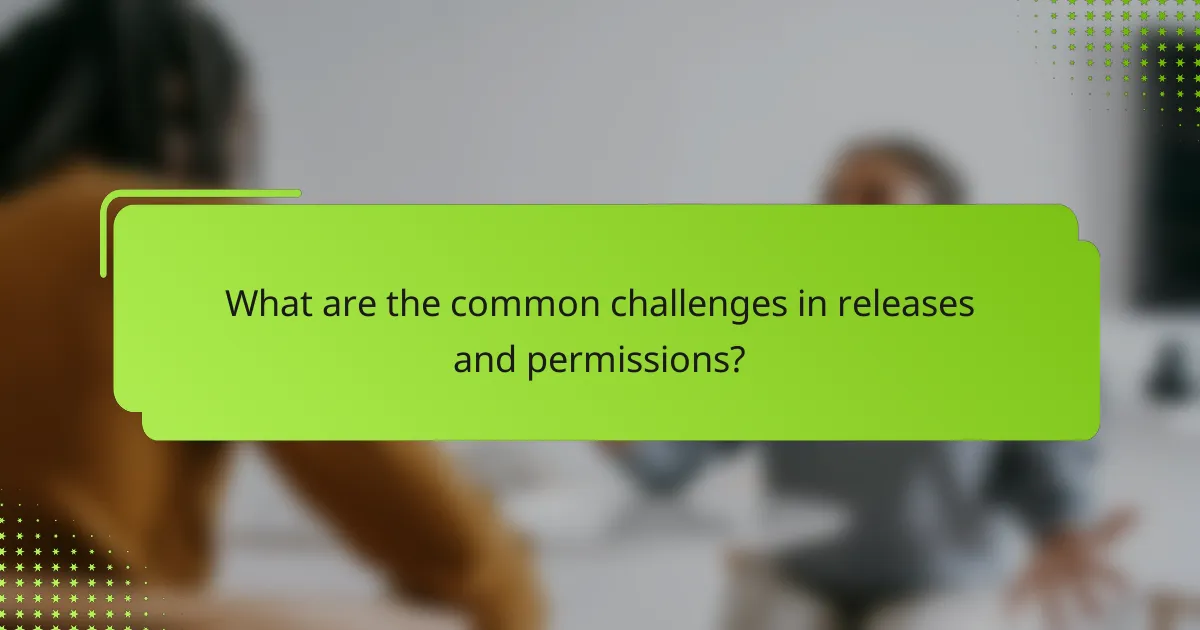
What are the common challenges in releases and permissions?
Common challenges in releases and permissions include miscommunication with stakeholders, inadequate documentation, and legal compliance issues. These obstacles can lead to delays, increased costs, and potential legal ramifications if not addressed effectively.
Miscommunication with stakeholders
Miscommunication often arises when stakeholders have differing expectations regarding the release process. This can result in confusion about timelines, responsibilities, and deliverables. Regular updates and clear channels of communication can help mitigate these issues.
To avoid miscommunication, establish a shared understanding of project goals and timelines from the outset. Utilize project management tools to keep everyone informed and engaged, ensuring that all parties are aligned throughout the release process.
Inadequate documentation
Inadequate documentation can lead to misunderstandings and errors during the release process. Without comprehensive records, teams may struggle to track changes, approvals, and requirements, which can cause delays and rework. Maintaining thorough documentation is essential for a smooth release.
Implement a standardized documentation process that includes templates for release notes, approval forms, and checklists. This will help ensure that all necessary information is captured and easily accessible to all stakeholders involved in the release.
Legal compliance issues
Legal compliance issues can pose significant challenges during releases, especially in regulated industries. Failing to adhere to relevant laws and regulations can result in fines, legal disputes, and reputational damage. It is crucial to understand the legal landscape surrounding your project.
To navigate compliance effectively, consult with legal experts early in the release process. Regularly review applicable regulations and incorporate compliance checks into your release workflow to ensure that all necessary permissions are obtained and documented properly.
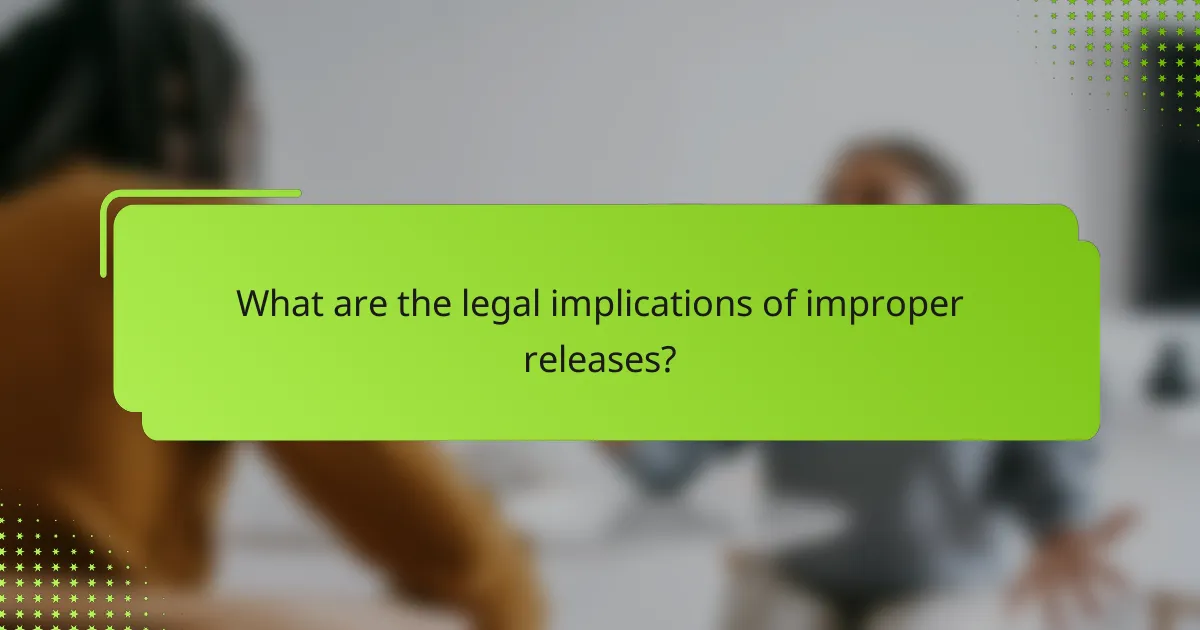
What are the legal implications of improper releases?
Improper releases can lead to significant legal issues, including lawsuits and financial penalties. Ensuring that all necessary permissions are obtained protects individuals and organizations from potential legal repercussions.
Potential lawsuits
Improper releases can expose individuals and companies to lawsuits from parties claiming unauthorized use of their likeness, voice, or intellectual property. For example, if a filmmaker uses footage of a person without their consent, that person may file a lawsuit for invasion of privacy or misappropriation.
To mitigate the risk of lawsuits, it is essential to obtain clear, written releases from all individuals featured in any media. This includes actors, musicians, and even bystanders in public settings. Always keep these documents organized and accessible for future reference.
Fines and penalties
Violating release agreements can result in substantial fines and penalties, which vary by jurisdiction. In some cases, penalties can reach thousands of dollars, depending on the severity of the infringement and local laws.
Organizations should familiarize themselves with relevant regulations and industry standards to avoid these financial repercussions. Regular training on the importance of obtaining proper releases can help prevent costly mistakes and ensure compliance with legal requirements.



